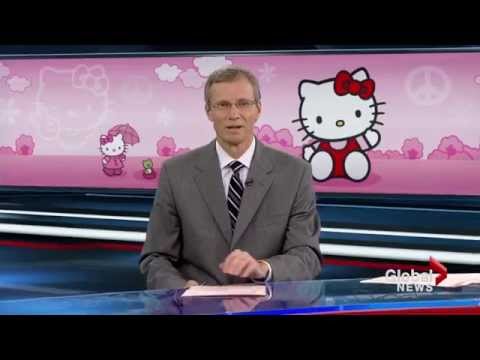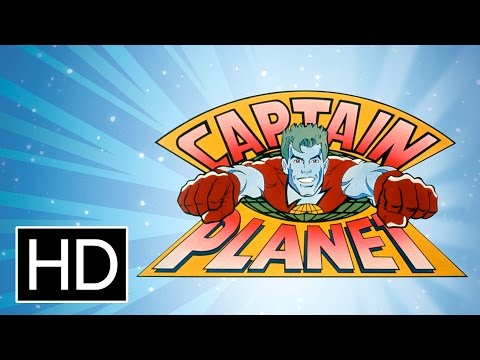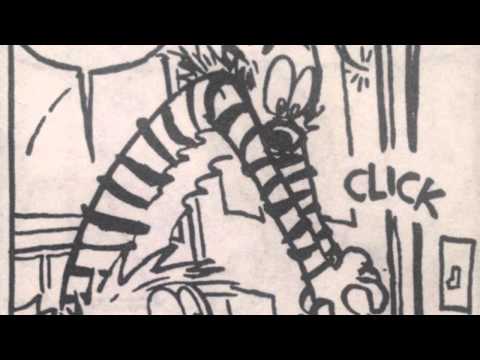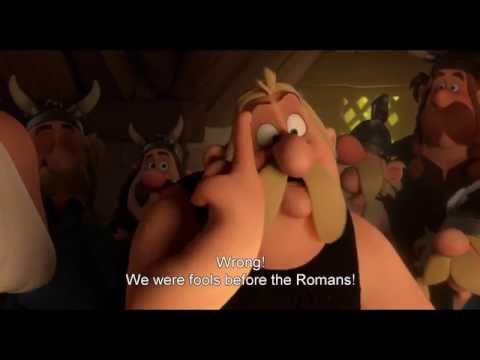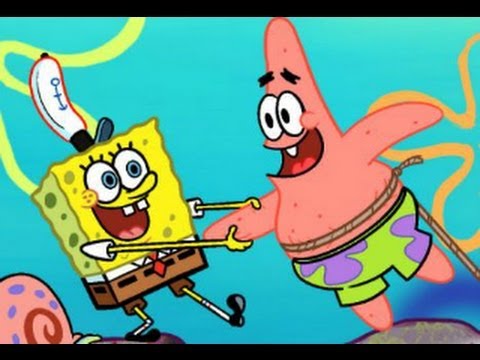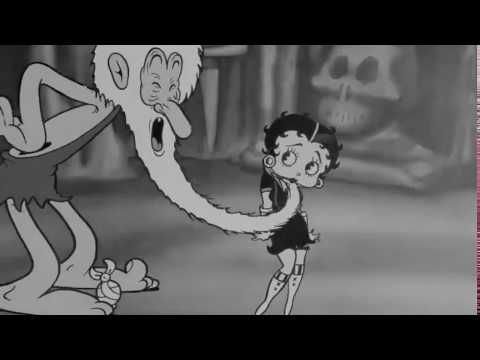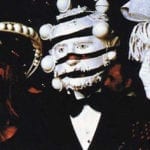10 Hello Kitty’s Origins
In 2014, the popular feline character Hello Kitty courted controversy when the company who created her, Sanrio, insisted the character was not actually a cat but a British girl living in London with her family. “She is not a cat,” anthropologist Christine R. Yano told the LA Times when discussing how Sanrio corrected her portrayal of Hello Kitty for a retrospective. “She’s never depicted on all fours. She walks and sits like a two-legged creature. She does have a pet cat of her own, however, and it’s called Charmmy Kitty.” The idea was said to have come from a period during the 1970s when many Japanese people, particularly women, visited and fell in love with exotic British culture. Many overseas fans of the brand were shocked by the revelation and refused to believe it. This is not the only strange controversy to erupt over the character. A persistent online rumor claims the character was invented as a tribute to Satan by the thankful parents of a child saved by the Devil from dying of mouth cancer. Supposedly, this is also the reason why the character is usually portrayed without a mouth, although the company has said it was a design choice that allowed fans of the character to project their emotions and interpretations onto the enigmatic feline. There are even silly claims that the Chinese word for demon is “kitty,” which is untrue. Another theory claims the character began as the symbol of a nuclear power plant, but the character became so popular that people forgot about the nuclear connection. That theory is also linked to earlier beliefs that the Cabbage Patch Kids were designed to represent human deformities caused by exposure to radiation.
9 Crayon Shin-chan’s Irreverent Perversity
The popular Japanese children’s cartoon character Crayon Shin-chan is known for his irreverent, lewd, and disrespectful behavior, characteristically greeting the elderly with the question: “When are you going to die?” Though highly popular in Japan and other countries throughout Asia and Europe, he has also suffered negative attention from puritanical authorities. In 2014, the Indonesian broadcasting commission declared the children’s show to be “borderline pornography” due to Shin-chan regularly baring his buttocks to moon people and showing his genitals in his notorious “Mr. Elephant” dance. The commission also objected to the cartoon’s depictions of scantily clad women and lewd scenes. They demanded the private network broadcasting the series either cut the offending scenes or broadcast them at a later time when they wouldn’t be seen by young viewers, but the network refused. The show has also run afoul of censors in India, South Korea, and Vietnam. In India, concerns were raised over the effect the irreverent boy was having on young viewers. Clinical psychologist Rajat Mitra performed a trial where three- to five-year-olds were exposed to the program, and then their behavior was observed. “Shin Chan shows you can be smarter than adults and even fool them,” Mitra explained to The Times of India. “His naughtiness is exciting and gives kids a sense of high by which they can become equal to adults.” The program was banned by India’s Ministry of Information and Broadcasting in 1998 for promoting anti-Indian values, but a censored version has since returned to the airwaves.
8 Captain Planet And Lucifer
Some conservative Christians and Mormons point to the popular 1990s cartoon with environmentalist themes, Captain Planet and the Planeteers (and its sequel, The New Adventures of Captain Planet ), as clear evidence of the occult indoctrination of children. They believe the presence of the earth spirit Gaia, who gives the planeteers their magic rings to summon the hero Captain Planet, is a clear stand-in for Lucifer. Supposedly, Gaia is worshiped by occultists. The power of the five planeteers to call for Captain Planet with the power of the five magic rings is said to represent the power of children’s will to summon Lucifer. The beams of light erupting from the magic rings are seen as a reflection of classic Satanism, where an occult adept would produce power from his fingers or hand. The antagonists, representing pollution and environmental destruction, are said to be related to exaggerated propaganda to get people used to the idea of a New World Order global Satanic dictatorship in order to save the Earth. An unrelated controversy erupted with the 1992 episode “A Formula for Hate,” which explored the dangers of public misinformation about AIDS. LGBTQ activist Taylor Cole Miller claims the show included scenes alluding to a pro-gay agenda as a way to be sensitive to gay viewers without alerting anti-gay viewers to the subtext.
7 Calvin And Hobbes And Clickhole
Bill Watterson’s beloved comic strip Calvin and Hobbes, featuring precocious brat Calvin and his possibly imaginary tiger companion Hobbes, was no stranger to controversy during its run. Watterson was noted for his refusal to license his characters for merchandise like T-shirts, cups, etc. Although Watterson refused to compromise his artistic integrity to make extra money, his syndicate was adamant that they didn’t need his permission to license the characters. During the battle, bootleg T-shirts and car decals with a urinating Calvin popped up, but there was never any official merchandise. Eventually, Watterson was ready to quit over the issue, under the full awareness his syndicate could give the rights to his characters to more pliable artists and writers. Afraid to lose the cartoon’s creator, the syndicate relented, and Watterson won the battle. Another controversy emerged with subscriber newspapers over the Sunday format. While many newspapers were eager to give comics less valuable newspaper space, Watterson demanded half a page of space for his comic. Many other cartoonists criticized Watterson as a prima donna over the issue, but a compromise was reached in which newspapers had the option of shrinking the comic to a quarter page. Many kept it at half a page, with some saying it led to a golden age for the Calvin and Hobbes strip. Clickhole, a subsidiary of the Onion parody newspaper, posted a video in 2014 entitled “If You Grew Up With ‘Calvin and Hobbes,’ You Need to Watch This Now.” The transgressive video depicted the character of Calvin and his possibly imaginary tiger companion engaging in sexual relations. Although meant as a twisted satire on childhood nostalgia, it ran afoul of US laws on child pornography, which also covered comics and cartoons. These laws prohibit obscene depictions of sexually explicit conduct involving children, extending to simulated bestiality and other sexual activity, whether or not the genitals or pubic area appear. It is not clear whether the Clickhole video meets the standard of being obscene, or whether it is protected by cultural or artistic worth, but a strict interpretation of the law may declare it to be child pornography. Viewing the cartoon may be technically illegal, and YouTube quickly removed the video from its website on those grounds. In an interview with Fast Company, one Clickhole editor tried to vaguely justify the cartoon: “I think we just wanted to try and hit nostalgia from a different angle. Ultimately what happened was some people liked it, some people didn’t. It’s very common for anything in the Onion universe to have that kind of response.”
6 Uderzo’s Asterix
One of Europe’s most iconic comic book characters is Asterix, a scrappy protagonist from a single Gaulish village holding out from Roman domination thanks to a handy indomitability potion brewed by the local Druit Getafix. The original books were known for their clever puns (which had to be altered for each foreign language translation), fun storylines, and sarcastic depictions of different ethnic groups through ancient analogs. The Asterix comics were written by Rene Goscinny and drawn by Albert Uderzo between 1959 and 1977, when Goscinny passed away. Uderzo continued to produce Asterix comics, but they weren’t considered as good as the pair’s collaborative work and often came with a fair degree of controversy. The last Asterix book produced by Uderzo was Asterix and the Falling Sky in 2005, which was criticized by some for its inclusion of the unusual elements of aliens and superheroes that appear to be modeled after American and Japanese comic styles and tropes. It was also noted for its anti-Bush and anti-American bias, with the superheroes led by a dictator called “Hubs” (an anagram for Bush) and the anime-style alien invaders depicted as universally hostile invaders clad in cockroach-like armor with vague martial arts abilities. Long-term fans criticized the comic for its simplified drawing style as well as its outlandish themes. After Uderzo finally retired in 2009, a legal battle ensued between his daughter, Sylvie, and the comic book publisher over whether new writers should be allowed to take over the Asterix stories, despite her father being fine with the idea. In 2013, the first comic written by a new author/illustrator team, Asterix and the Picts, which featured Scottish satire, was finally released. Sylvie Uderzo had written an open letter in Le Monde in 2009 pleading with Asterix fans to help her protect the character from his “worst enemies: the men of industry and finance.” In 2015, Uderzo caused even more controversy over a pair of cartoons he drew as a tribute to the victims of the Charlie Hebdo attacks, which he posted to the official Asterix Twitter account. In one, Asterix is depicted shouting, “Moi aussi, je suis une Charlie” (Me too, I’m also Charlie) and punching a man out of his shoes, which appear to be babouche slippers associated with North African culture. Al Jazeera reporter Massoud Hayoun posted a tweet saying the image was racialist and represented “underlying anti-immigrant sentiment in French society.”
5 Racist Tintin
The Belgian comic character Tintin was a plucky Belgian reporter that went on adventures around the world, even visiting the Moon. However, several books were criticized for their racist and patronizing depictions of nonwhite peoples, though some blame this on the evolving views of author Georges “Herge” Remi. This was particularly glaring in Tintin in the Congo, written in the 1930s, which depicted native Congolese as dim-witted and childlike, with one female Congolese character prostrating herself before Tintin and saying, “White man very great. White mister is big juju man.” This has led to the book being moved to the top shelf of some European bookstores, though a Belgian court shot down an attempt by Congolese immigrant Bienvenu Mbutu Mondondo and the Belgian Council of Black Associations to have the book banned. The court characterized it as full of “gentle and candid humor.” Modern Congolese have mixed opinions, with some saying the comic was obviously racist and others defending the still-popular character. Auguy Kakese, an artisan who runs a workshop producing Tintin statuettes, said: “It’s humor, it’s not racist . . . for those who say it’s racist I say that in the comic strip, you never see images which show him trying to kill the Congolese.” Others are unconvinced, seeing it as emblematic of the troubled and bloody Belgian colonial history in the country. Other Tintin comics have come under similar fire for their depiction of different ethnic groups. The Shooting Star, originally featuring villainous characters in the form of Jewish debtors and an American financier called Blumenstein, and Land of Black Gold, originally featuring antagonists in the form of Jewish terrorists led by a rabbi, both came under fire for being anti-Semitic. Tintin in the Land of the Soviets has been characterized as blatant anti-Soviet propaganda, with The Blue Lotus depicting the Japanese in a negative light. Tintin in America depicted Native Americans in a stereotypical way, more similar to 19th-century Native Americans despite being set in the 1930s, and filled with offensive language like “paleface” and “squaw.” Remi himself later expressed regret over some of these depictions, referring to the Congo story as a “youthful sin.” Many have ascribed the portrayals as stemming from ignorance rather than malevolence. While young Remi was broadly sympathetic to native peoples as “underdogs,” he was an unworldly individual who had never left Europe at the time he began to draw his famous comics.
4 The Eternal Copyright Of Mickey Mouse
When the Copyright Act was first enacted in 1790, it only lasted 14 years, renewable once if the original creator was still alive. Today, copyright can extend for as long as a century. Some blame this steady expansion of copyright protections on Mickey Mouse and the desire of The Walt Disney Company to maintain control of the character. When Mickey debuted in Steamboat Willie in 1928, existing laws gave copyright protection for a maximum of 56 years, expiring in 1984 for Mickey with the renewal. Pressure from Disney may have led to the passage of retroactive legislation in the 1970s granting protection for an author’s life plus 50 years. The legislation extended protection for Mickey to 2003. These laws were changed again in 1998 to the life of the author plus 70 years, giving Mickey protection until 2023. Many are unhappy by these repeated changes, believing it robs future generations of the opportunity to build on works associated with our current culture (although South Park doesn’t seem to have a problem with it as shown in the video above). However, it’s likely that Disney will continue to fight for control of their iconic mascot. Disney’s desire to maintain control of Mickey can be traced to Walt Disney himself, who was furious over losing control of the first important Disney character, Oswald the Lucky Rabbit, to distributor Charles Mintz. Based on a redesign of Oswald, Mickey kept many of the rabbit’s mannerisms and personality traits, although Mickey was originally named Mortimer. From those rocky origins, Mickey Mouse has had more than his fair share of controversies over the years, particularly due to early behavior in comic strips seen as offensive or vicious today. These included a number of “hilarious” suicide attempts over Minnie Mouse dating another man, struggles with opium smugglers, and a homophobic attack on a cross-dressing and camp cat character, in which Mickey refers to another presumably gay character as a “big cream-puff inhaler.”
3 Beavis And Butt-head’s Bad Influence
In 1993, a five-year-old child in Ohio caused a fatal house fire that was blamed on exposure to the Beavis and Butt-head television program. The boy had set his bed on fire with a cigarette lighter, causing a blaze that ultimately killed his two-year-old sister. The children’s mother blamed the incident on her son imitating the cartoon, which made frequent sniggering references to fire and burning things. As Moraine Fire Chief Harold Sigler explained to the Los Angeles Times : “When you take a child in the formative years and you get these cartoon characters saying it’s fun to play with fire . . . this is going to stick in that kid’s mind and it’s going to be with him for a long time.” MTV denied a connection between the tragedy and the cartoon. Still, they edited out the fire scene in “Comedians,” an episode which culminated in Beavis burning down a comedy club. In the 1990s, Beavis and Butt-head was often criticized and even banned for its negative influence on children and youths, blamed for incidents of property damage and animal cruelty. After hearing that some kids had imitated the disgusting duo by placing a firecracker in a cat’s mouth to kill it, Marin County resident Dick Zimmerman pledged to use his $7.1 million in state lottery winnings to make sure the show was taken off the air. He even set up a hotline for individuals to vent their outrage about the show or help to have it removed. Many people also criticized Beavis and Butt-head for frequently showing the main characters engaging in antisocial behavior like vandalism and huffing paint thinner. The show was both praised and damned for its crude representation of the alienation and anti-intellectualism of 1990s youth. While Rolling Stone called it “The Voice of a New Generation,” Newsweek said, “The downward spiral of the living white male surely ends here: in a little pimple named Butt-head whose idea of an idea is, ‘Hey Beavis, let’s go over to Stuart’s house and light one in his cat’s butt.’ ” Others described the program as a scatological but subversive piece of political and cultural criticism of early post–Cold War America.
2 SpongeBob’s Gay Agenda
The idea that SpongeBob SquarePants is thinly veiled homosexual propaganda has been floating around as an urban legend in the religious far right for years. Focus on the Family founder James Dobson made the first link when he criticized a video featuring SpongeBob that was produced by the We Are Family Foundation, which promotes tolerance. Watch this video on YouTube Belief that the sea sponge is homosexual is based on frequent rainbow imagery and his tendency to holds hands with his best friend, starfish Patrick Star. The concept was largely ridiculed, although some took it seriously. As reported by Cartoon Brew, David J. Steward said: Then there’s the recent Sponge Bob Gay-Pants dilemma. Look . . . if you don’t want people to think Sponge Bob is homosexual, then don’t feature him in a “diversity” video which obviously is implying that sodomites should be accepted as well. The flashing colors of Sponge Bob are a clear indicator to me. Everyone knows that the rainbow has become the hallmark of the homosexual movement. By the way, nothing is any more blasphemous to the Bible than the Sodomites stealing of the rainbow. It is God’s rainbow, not the homosexuals! While SpongeBob is a popular character among some in the gay community, his creator Stephen Hillenberg has gone on record as saying he intended the character to be asexual. The controversy originated in the US, but it did spread to other countries. In 2012, the Ukraine’s National Expert Commission for Protecting Public Morality tried to ban the cartoon by claiming it promoted homosexuality and describing it as a “social experiment” to turn Ukrainian children into “criminals and perverts.” The Commission’s report also accused other cultural imports like The Simpsons, Family Guy, Pokemon, The Teletubbies, and Futurama of having a negative effect on Ukrainian youth.
1 The Censorship Of Betty Boop
In the 1930s, Betty Boop was among a stable of characters, including Popeye and Superman, used by Fleischer Studios to compete with Walt Disney. Betty Boop was first introduced as the girlfriend of the character Bimbo in Dizzie Dishes, portrayed as a dog with a woman’s legs and spit curls. By 1932, she had become human and gained her name, becoming known for her risque cartoons, short skirt, and low-cut dress that frequently came off. The 1920s were a sexually liberated time compared to the subsequent generation. As a result, Betty Boop was frequent depicted nude or seminude and felt up by secondary characters. She was the first female cartoon character represented as an unapologetically sexual being. Her cartoons became known for their surreality and freewheeling jazz background music. Popular singer Helen Kane sued Fleischer for allegedly stealing her look and her trademark expression “Boop-oop-a-doop!” But she didn’t win. With the advent of the Hays Code in the mid-1930s, censorship changed the character completely as the movement to clean up the cartoon industry was launched. Her dress became longer, and she was less sexualized. But in the process, the character lost much of her personality. She was no longer portrayed as a liberated flapper but limited to more traditional and “pure” roles: teacher, secretary, housewife, and babysitter. She was also joined by more innocent side characters like Grampy, a wacky older inventor, and Pudgy, a cute dog. The weird, surreal story lines became more sedate, and Betty was shown as taller with a smaller head. Even so, Max Fleischer slipped a zinger past the Hays Code in a cartoon entitled “A Language All My Own,” in which Betty sings a song in English and Japanese. The English portion was innocent, but the Japanese refrain included a line meaning “Come to bed with me and we’ll boop-oop-a-doop!” Still, the new version of Betty proved less popular. Her cartoon career came to a sad end by 1939, although she enjoyed a revival in syndication in the 1950s and became a symbol of the counterculture in the 1960s and 1970s. David Tormsen is also animated and controversial. Email him at [email protected].
